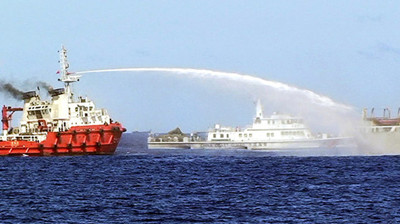南海
Not the usual drill
非一般鉆井
Tensions mount dangerously in contested waters
爭(zhēng)議水域局勢(shì)緊張
BARACK OBAMA'S tour of four countries in Asia late last month was supposed to reassure America's friends of its commitment to the region, and to deter China from provocations in its many territorial disputes. In the South China Sea, at least, the tactic has not worked. China's quarrel with Vietnam, which had been dormant in recent months, flared up dangerously this week. And a new front opened in China's continuing tussle with the Philippines over different parts of the sea.
奧巴馬上月末訪問亞洲四國,本應(yīng)令盟友對(duì)其“重返亞洲”的承諾安心,并阻止中國挑起其諸多領(lǐng)土爭(zhēng)端。但至少在南海,這個(gè)戰(zhàn)略不起作用。中國與越南的糾紛緩和數(shù)月后,本周再度劍拔弩張。此外,中國與菲律賓又因持續(xù)不斷的主權(quán)爭(zhēng)議另一海域發(fā)生新沖突。

Vietnam first. China sent its new $1 billion rig, the Haiyang Shiyou 981, to drill for oil in waters that Vietnam regards as inside the exclusive economic zone (EEZ) it is entitled to under the international law of the sea. Vietnam demanded that the rig be withdrawn and sent nearly 30 coastguard vessels to try to stop it starting work. A protective Chinese flotilla repulsed them, ramming one and firing water cannon at others. China has declared a three-mile exclusion zone around the rig, larger than is normal.
越南首當(dāng)其沖。中國運(yùn)送新的鉆井平臺(tái)“海洋石油981”進(jìn)行海上石油鉆探,平臺(tái)價(jià)值10億美元。越南認(rèn)為中方作業(yè)區(qū)域位于其依國際海事法擁有的專屬經(jīng)濟(jì)區(qū)內(nèi),要求中方撤離鉆井平臺(tái),并派出近30艘海警船試圖制止中方再度作業(yè)。中國護(hù)衛(wèi)艦隊(duì)驅(qū)逐了越方海警船,撞擊一艘并向其余船只發(fā)射水炮。此前中方宣布“海洋石油981”鉆井平臺(tái)半徑3海里范圍為禁航區(qū),這大于正常值。
It insists the rig is operating in its own waters. It appears to claim that the area is within the EEZ attached to an island chain it controls, which China calls Xisha and the Vietnamese Hoang Sa. The islands, the Paracels in English, have been occupied by China since 1974, when it drove out the former South Vietnamese regime. Vietnam still regards them as part of its territory.
中方堅(jiān)持鉆井平臺(tái)的作業(yè)區(qū)完全位于本國海域,聲稱這片區(qū)域在其專屬經(jīng)濟(jì)區(qū)內(nèi),連接著由中方控制的島鏈(中國稱之為西沙群島,越南則稱黃沙群島)。這片島鏈英語名稱為Paracel,中國于1974年趕走島上的越南政權(quán)后便占領(lǐng)了這里。但是越南仍視之為自己的領(lǐng)土。
As always, China's claim is hazy. It produces maps with a vast U-shaped area covering almost the entire South China Sea, enclosed in a “nine-dash line”, which it says gives it historic rights to the land inside. This uncertainty has created tension in various parts of the sea, where the Philippines, Malaysia, Brunei and Taiwan also have claims. The dispute with the Philippines is the most active. That, too, intensified this week when the Philippines arrested 15 Chinese fishermen for poaching hundreds of endangered turtles in what it sees as its own waters.
中國的主張一如既往的含糊。它制作地圖時(shí)劃出一片巨大的U型地帶,用九段虛線將幾乎整個(gè)南海劃在國土范圍內(nèi),并稱自古以來對(duì)里面的土地?fù)碛兄鳈?quán)。這個(gè)不明確性在各海域形成緊張氣氛,包括菲律賓、馬來西亞、文萊與臺(tái)灣等國家和地區(qū)。其中與菲律賓的沖突最頻繁。本周菲律賓扣留了15名中國漁民,理由是這些漁民在菲律賓視之為領(lǐng)海的地方偷捕瀕危海龜,緊張局勢(shì)再度升級(jí)。
Mr Obama's trip was marked by a beefing-up of America's security ties with the Philippines, but not by an explicit American commitment to back it in the South China Sea. Vietnam is not an American ally, although relations have warmed in recent years, partly because of Vietnam's fear of China. America has condemned China's “provocative” drilling plans but may prove powerless to thwart them. That could undo whatever progress Mr Obama made on the reassurance front.
奧巴馬此行被認(rèn)為加強(qiáng)了美國與菲律賓的安全關(guān)系,而非美國重返南海的明確承諾。盡管近年美越關(guān)系好轉(zhuǎn),但越南并不是美國的盟友。部分原因是越南對(duì)中國的擔(dān)心。美國譴責(zé)了中國的“挑釁性”鉆探計(jì)劃,但或許無法阻止該計(jì)劃實(shí)行。那可能使得奧巴馬在安撫盟友方面取得的進(jìn)展功虧一簣。














